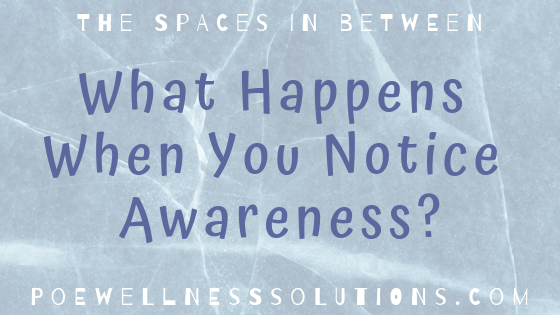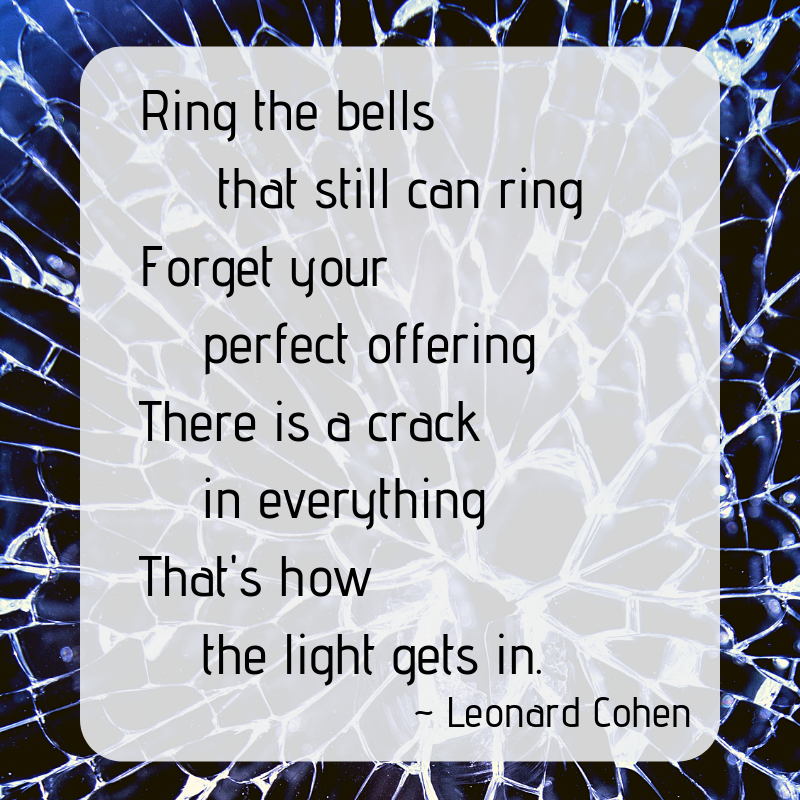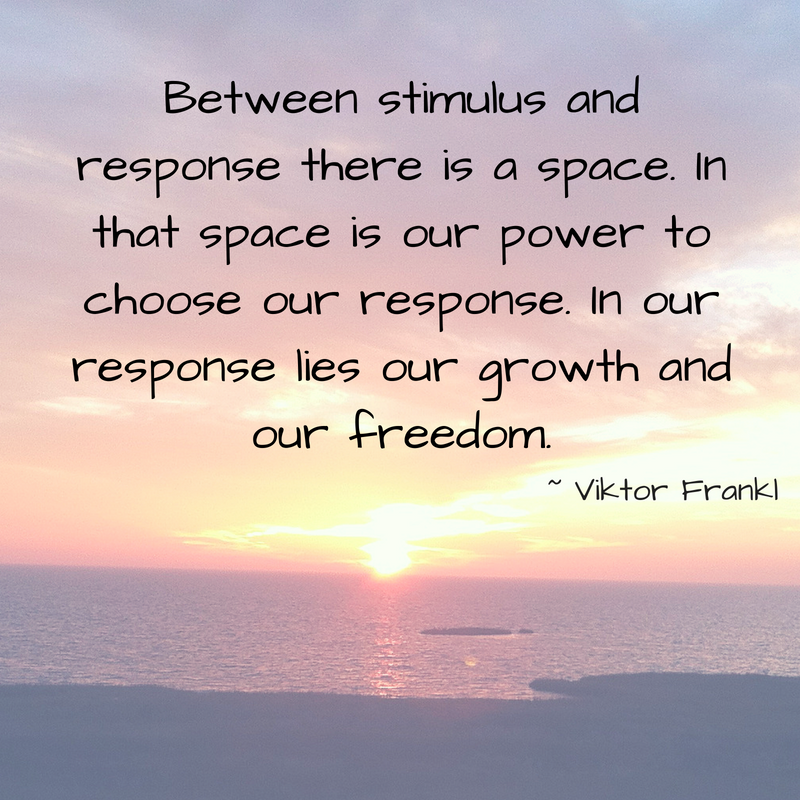
The Spaces In Between … Over the past few years, these words (or similar words) continue to find their way into my day and have come to signify paying attention to my life, being more mindful, noticing when I am aware (and when I am not) and learning to change my perspective with awareness.
That’s How The Light Gets In

The first time this idea hit me was when my dear friend Wendy invited me to see Leonard Cohen in November of 2009. Although I knew his music, it was not until that night that my love for Leonard Cohen began. I was mesmerized by his magical words. Who doesn’t love the song, Hallelujah?! But what got me even more was when he read the lyrics to Anthem. There is a crack in everything. That’s how the light gets in. That struck me. Our tendency is to get so caught up in “the thing” that we see the crack as what’s wrong. What if we change our perspective? The crack doesn’t have to be what’s wrong. Maybe it’s what right. It shines light. It allows us to see more clearly. To me, it was the beginning of noticing the spaces in between.
Stimulus & Response

This Viktor Frankl quote was shared during a Mindfulness Yoga Teacher Training at the Asheville Yoga Center in Asheville, NC. It’s not only about noticing the spaces in between but creating the spaces. It’s the power of the pause, creating a moment between something happening and your reaction. Sudden reactions are exactly that … quick and reactive. When you notice the stimulus, pay attention to what’s happening, create a space, pause, you find your power. You respond with greater attention. When you become aware, when you notice your awareness, you find your super power.
Empty Space
This mindfulness exercise was the clincher for realizing the value of The Spaces In Between. For two years, I enjoyed facilitating Wake Up To Your Life, a twice per month mindfulness activity webinar. Activities were selected from Jan Chozen Bays’ book, How to Train a Wild Elephant: And Other Adventures in Mindfulness. Participants were from around the world. Each time we met, we reviewed the mindfulness activity explored the two previous weeks, shared our stories, challenges, lessons learned and reviewed the activity for the next two weeks. We learned a great deal about each other, ourselves and how to navigate the world with greater awareness. At the time, this activity was not a favorite but it stuck with me and continued to develop my interest in The Spaces In Between.

The mindfulness activity is called Empty Space. This is the assignment.
As often as you can, shift your awareness from objects to the space around the objects. For example, when you look in the mirror, notice the space around the image of your head. In a room, notice the empty space rather than the furniture, people, or other visual objects.
According to the book, these are discoveries and deeper lessons.
Ordinarily our focus is on objects. Inside a house we focus on the people, animals, furniture, appliances, dishes, and so forth. Outside we still have tunnel vision, focusing on buildings, trees and plants, vehicles, animals, roadways, signs, and people. It takes an effort to shift our awareness to the space around all these objects or within rooms. Opening the mind to this space is somehow restful. Is our anxiety linked to objects? This task can be a potent tool of awareness if people consistently practice with it. One student commented that ikebana, the Japanese art of flower arranging, helped her appreciate space. “I am learning to see space, which is as important as the objects in the space. Space keeps everything from being jumbled together and helps reveal the beauty of the leaves, branches, and flowers.” Similarly, space in our mind keeps everything from being covered over with a jumble of thoughts and reveals the simplicity and beauty of everything we see. Another person added, “When I looked at the space around an object, it suddenly ‘popped’ out and became more vivid. I also saw how chairs and many other things function only because of their empty space.”
Our identity is bound up in objects, objects that reinforce our sense of self. “I’m a book collector,” “I have the latest entertainment center,” “I have beautiful art on my walls,” “I have five cats.” All day long we spend time engaging with objects. Our desire is focused on the things, animals, and people we want to occupy the space around us. We seldom step back and see the background, the empty space that makes up most of a room, a building, or an outdoor vista. When we are able to shift our awareness to the space around objects, there is a sense of relief. It is equally important to perceive the space that exists within the mind. When we can let go of thoughts and hold our awareness on the mind-ground behind the thoughts, there is an immediate feeling of relief.
Bays MD, Jan Chozen. How to Train a Wild Elephant: And Other Adventures in Mindfulness (pp. 102-104). Shambhala.
Summing It Up
So what happens when you notice awareness, when you pay attention to the spaces in between? It depends on who you are and how you see the world. According to Leonard Cohen, It’s how the light gets in. Ask Viktor Frankl, It is where our power lies. In Jan Chozen Bays’ book we learn we may find a sense of relief, feel less jumbled, or reveal the simplicity and beauty of everything we see.
For me, this is a work in progress and at times a bit of an obsession. It can bring relief but I can also get caught up in my continuous noticing of new spaces as my view shifts and then shifts again. I enjoy the evolution in my perception of day-to-day life . Check out other posts about The Spaces In Between (coming soon). What happens when you are aware of the spaces in between? What do you notice when you notice awareness? Love to hear your comments, stories, ideas, etc.

Loved this, Meg!
Especially not only mindfulness of the spaces in between, but creating them!
Will respond more personally, but THANKS!
Hi Gregg,
I am happy that you enjoyed this. It is always a little odd writing a blog posts. I have ideas but never sure how to get out the words. I have been thinking about the spaces in between for some time. There is value there for me and I am not confident yet how to articulate that value. I decided to take the approach I encourage with my clients … trial and learn.
Your continued support means more than you can imagine. Look forward to your personal response.
In health + happiness,
meg